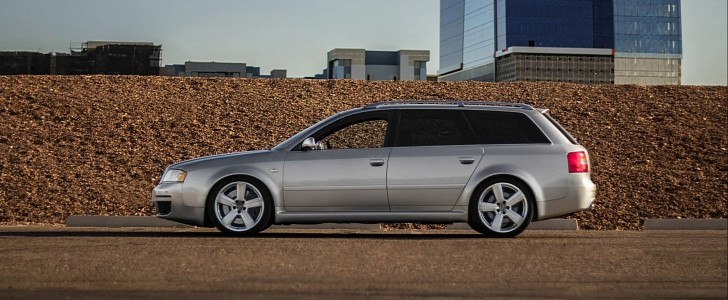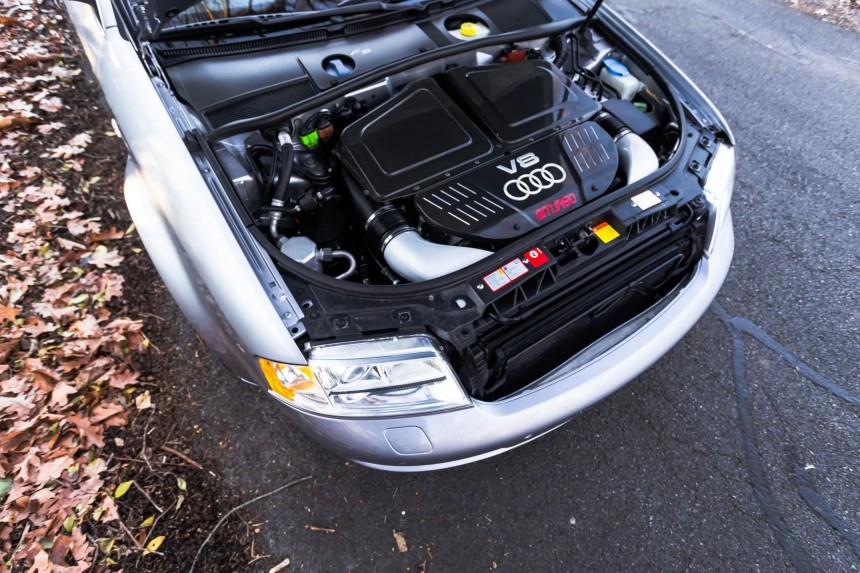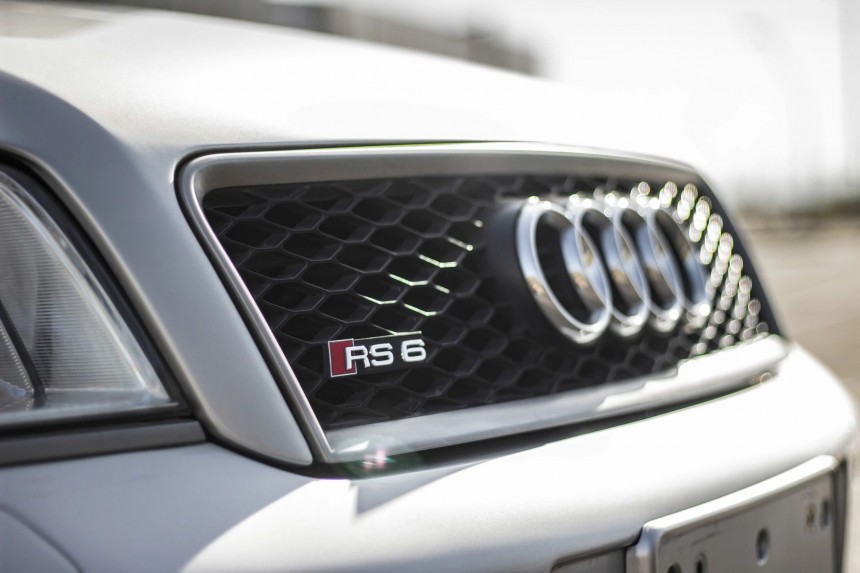Masterminded by Ferdinand Piech, the RS 2 Avant was met with raving approval from performance car enthusiasts. The subsequent RS 4 Avant made quattro GmbH – now called Audi Sport GmbH – a household name. The grandson of Ferdinand Porsche also championed the first-ever RS 6, which launched six months after RS 4 Avant production came to a halt.
Presented to great critical acclaim in March 2002 at the Geneva Motor Show, the RS 6 is the first RennSport offered in both five-door Avant and four-door Sedan body styles. The second-generation RS 6 was offered in these forms, but Audi discontinued the sedan from the third-gen onward.
Based on the Volkswagen Group’s then mid-range platform, the first generation bears a similarity to the RS 4 Avant before it. More specifically, quattro GmbH and Cosworth collaborated on the 4.2-liter BCY engine.
The Cosworth-tuned V8 was a technological marvel for that period, more so if you remember that quattro GmbH wasn’t up there with the go-faster division of Mercedes and Bayerische Motoren Werke in the early 2000s. Based on the five-valve-per-cylinder lump of the S6, the eight-cylinder mill is rocking a pair of thumpin’ spinny lads and two air-to-air intercoolers.
Managed by a Bosch Motronic ME 7.1.1 control unit, the BCY further sweetens the deal with multi-point sequential fuel injection, variable inlet valve timing, four catalytic converters, and a 9.3:1 compression ratio. The Alusil cylinder heads are complemented by a cast aluminum block with a 90-degree angle between the cylinder banks. The crankshaft is forged steel, and the KKK-supplied turbochargers can take up to 11.6 psi of boost.
The reason Audi limited the boost pressure to 11.6 pounds per square inch is rather obvious. The ZF-supplied 5HP24A transmission is the culprit, a torque-converter automatic with steering wheel-mounted buttons for manual control. Alternately, shifting can be done via the gear lever.
Gifted with the Dynamic Shift Program, which adapts the shift points as per the driver’s individual driving style, the RS 6 sends the goodies to both axles with the help of a Torsen-style center differential. An electronic differential lock is also featured, along with Anti-Slip Regulation. The ASR system incorporates Bosch’s ESP 5.7 electronic stability program.
Tipping the scales at 1,840 kilograms (4,057 pounds) for the sedan and 1,865 kilograms (4,112 pounds) for the wagon, the original RS 6 produces 444 horsepower between 5,700 and 6,400 revolutions per minute and 413 pound-feet (560 Nm) from 1,950 to 5,500 revolutions per minute.
The C5 in this particular specification likes to pull hard, and even by modern standards, 100 kilometers per hour (62 miles per hour) in less than five seconds is mighty impressive. Limited to 250 kilometers per hour (155 miles per hour), the RS 6 gained a special edition in April 2004.
Only available in the guise of a family-sized longroof, the RS 6 Avant Plus is two-tenths quicker and just a little faster to boot. Audi quoted 280 kilometers per hour (174 miles per hour) even though curb weight rose by 15 kilograms to 1,880 kilograms (4,145 pounds). A grand total of 999 examples were produced, all of them loaded with a standard kit.
The list starts with two additional radiators, cross-drilled brakes, anthracite-finished alloy wheels, xenon headlights, black optics for the exterior, lots of Alcantara and leather, carbon-fiber inserts, heated front and rear seats from Recaro, a small television, and cross-drilled brakes all around. Renamed BRV, the bi-turbo V8 was remapped to 473 ponies.
The non-Plus model wasn’t exactly spartan either. A rear spoiler, silver-finished roof rails for the Avant, perforated leather on the steering wheel, Alcantara for the headliner, aluminum trim, air conditioning, power mirrors and windows, Bose hi-fi audio, and sat-nav are the highlights.
From July 2002 through September 2004, the four-ringed automaker from Ingolstadt manufactured just under 8,100 examples of the breed. As opposed to the B5 RS 4, the C5 RS 6 was sold in the U.S. of A.
Based on the Volkswagen Group’s then mid-range platform, the first generation bears a similarity to the RS 4 Avant before it. More specifically, quattro GmbH and Cosworth collaborated on the 4.2-liter BCY engine.
The Cosworth-tuned V8 was a technological marvel for that period, more so if you remember that quattro GmbH wasn’t up there with the go-faster division of Mercedes and Bayerische Motoren Werke in the early 2000s. Based on the five-valve-per-cylinder lump of the S6, the eight-cylinder mill is rocking a pair of thumpin’ spinny lads and two air-to-air intercoolers.
Managed by a Bosch Motronic ME 7.1.1 control unit, the BCY further sweetens the deal with multi-point sequential fuel injection, variable inlet valve timing, four catalytic converters, and a 9.3:1 compression ratio. The Alusil cylinder heads are complemented by a cast aluminum block with a 90-degree angle between the cylinder banks. The crankshaft is forged steel, and the KKK-supplied turbochargers can take up to 11.6 psi of boost.
Gifted with the Dynamic Shift Program, which adapts the shift points as per the driver’s individual driving style, the RS 6 sends the goodies to both axles with the help of a Torsen-style center differential. An electronic differential lock is also featured, along with Anti-Slip Regulation. The ASR system incorporates Bosch’s ESP 5.7 electronic stability program.
Tipping the scales at 1,840 kilograms (4,057 pounds) for the sedan and 1,865 kilograms (4,112 pounds) for the wagon, the original RS 6 produces 444 horsepower between 5,700 and 6,400 revolutions per minute and 413 pound-feet (560 Nm) from 1,950 to 5,500 revolutions per minute.
The C5 in this particular specification likes to pull hard, and even by modern standards, 100 kilometers per hour (62 miles per hour) in less than five seconds is mighty impressive. Limited to 250 kilometers per hour (155 miles per hour), the RS 6 gained a special edition in April 2004.
The list starts with two additional radiators, cross-drilled brakes, anthracite-finished alloy wheels, xenon headlights, black optics for the exterior, lots of Alcantara and leather, carbon-fiber inserts, heated front and rear seats from Recaro, a small television, and cross-drilled brakes all around. Renamed BRV, the bi-turbo V8 was remapped to 473 ponies.
The non-Plus model wasn’t exactly spartan either. A rear spoiler, silver-finished roof rails for the Avant, perforated leather on the steering wheel, Alcantara for the headliner, aluminum trim, air conditioning, power mirrors and windows, Bose hi-fi audio, and sat-nav are the highlights.
From July 2002 through September 2004, the four-ringed automaker from Ingolstadt manufactured just under 8,100 examples of the breed. As opposed to the B5 RS 4, the C5 RS 6 was sold in the U.S. of A.





































